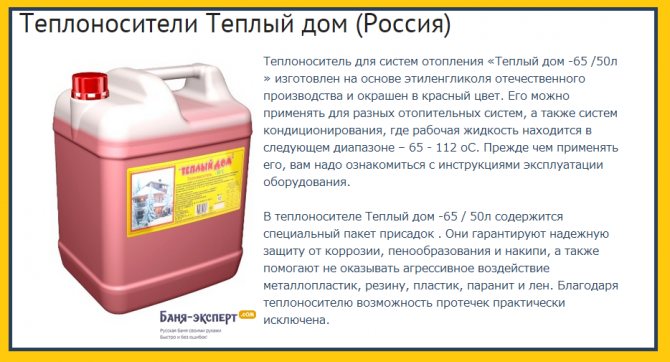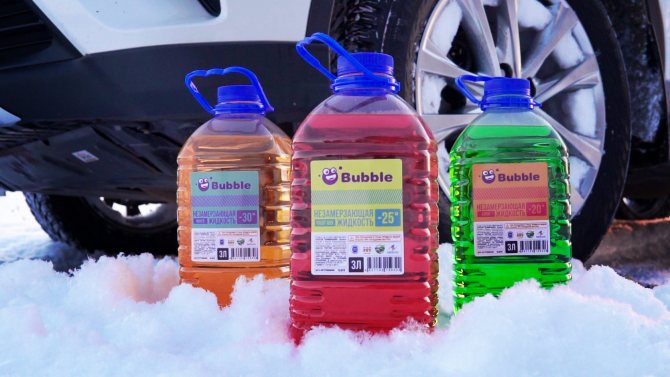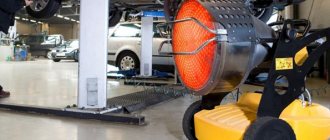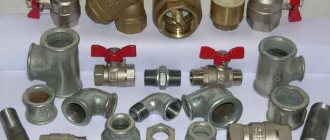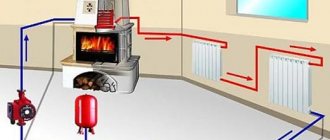Advantages of antifreeze heating fluid

- The main advantage can be considered the following: when the building will not be used for a long time, and the heating system, of course, is deactivated, then there is a great risk that in winter the frozen water can simply burst pipes. In the case of using antifreeze, this cannot happen. Therefore, such a coolant does not need to be drained.
- Special additives prevent the occurrence of corrosion, various kinds of plaque, and the dissolution of the sealant is excluded.
Disadvantages of antifreeze
- First of all, it is poisonous, so its use in dual-circuit systems is highly undesirable. In addition, antifreeze is highly flammable. Although in recent years, non-toxic propylene-based antifreezes have begun to appear in the country.
- This antifreeze liquid for heating systems has a lower heat capacity (about 1/5 lower than that of water).
- It is more viscous, so it will be more difficult to "move" it through the pipeline.
- Most importantly: antifreeze is completely incompatible with galvanized pipes!


I would also like to give a few words to fans of using antifreeze for cars as a coolant. It is not necessary to do this, since the antifreeze contains substances, the use of which in residential premises is unacceptable.
When should you not use antifreeze?
The subtitle sounds this way because you can familiarize yourself with the positive qualities of an anti-freeze liquid right at the time of purchase. But there are other qualities that manufacturers try not to expand on.
- For antifreeze, a sufficiently powerful circulation pump is needed, since its viscosity is higher.
- It cannot be used with double-circuit boilers (the reasons for this were indicated in the previous chapter).
- For antifreeze, more powerful radiators are also required, since it absorbs heat worse.
- Never use antifreeze in open systems. Then it can simply evaporate.
- Zinc can cause antifreeze to lose most of its properties.
Benefits of plain water


Firstly, water is relatively inexpensive, which is why it is available. Secondly, most boilers and other elements of the heating system assume precisely the use of water as a heat carrier. And, finally, if a leak occurs in the system, then ordinary water will spill into the room, which is absolutely harmless to the human body.
Cons of using water
There are several similar disadvantages at once.


- If the pipeline is made of metal, then sooner or later the water coolant will cause corrosion.
- Sudden frosts when the heating system is not started can cause pipeline rupture, sometimes it happens to the boiler itself. Material damage, you guessed it, will be significant.
- If, instead of good antifreeze, you use water, albeit purified, then soon a plaque will form on the surface of the pipes. It, in turn, leads to unnecessary consumption of the received energy (such a gap can reach thirty percent). And due to the fact that fuel costs a lot today, the cost of heating a house will be significant.
- The heat capacity of water is much higher.
- Overheating of the water in the system will not cause any serious problems, which cannot be said about antifreeze: in this case, it simply decomposes, forming acid.
Outcome
The choice, of course, will always remain with you, that is, with the consumer.Which antifreeze liquid for heating systems is better, and which is worse, cannot be said with certainty. Most likely, such a choice should be made based on a specific characteristic of the heating system, or even better - after consulting a specialist in advance.
What are the problems when using antifreeze liquid in heating systems?
Problem # 1
Since water and antifreeze have different physical characteristics, when designing a heating system, it should be taken into account whether one or another liquid will be used. Basic calculations are done, of course, for water. If you plan to use antifreeze, you will need to change some system parameters:
- boiler power;
- increase the head of the circulation pump by 60%;
- increase the volume of the expansion tank by 50%;
- increase the heat output of the radiators by 50%.


Problem # 2
Antifreezes based on ethylene glycol have one feature - they "do not like" overheating of the system. For example, if at any point in the system the temperature exceeds the critical temperature for a given brand of mixture, ethylene glycol and additives decompose, resulting in the formation of solid precipitates and acids. When precipitation falls on the heating components of the boiler, carbon deposits appear, as a result of which heat exchange decreases, the appearance of new precipitation is stimulated, and the likelihood of overheating increases.
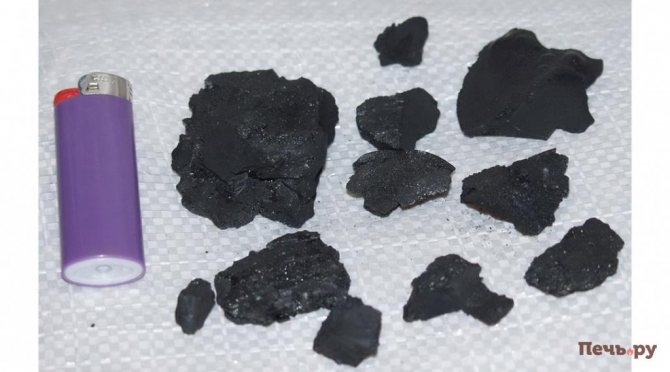

Acids formed during the decomposition of ethylene glycol react with the metals of the system, resulting in the development of corrosive processes. Decomposition of the additives can cause a decrease in the protective characteristics of the composition in relation to the seals, which can cause leakage at the joints. If the system is zinc coated, antifreeze must not be used. When overheated, increased foaming appears, which means that airing of the system is guaranteed. Therefore, in order to eliminate all these phenomena, the heating process must be tightly controlled. Since the boiler manufacturers do not know the physical properties of the used heat transfer fluids (other than water), they exclude their use.
Problems # 3
Antifreezes have increased fluidity. Consequently, an increase in the number of connecting points and elements entails an increase in the likelihood of leakage. Moreover, basically, such a problem appears when the system is cooled down, when the heating is turned off. Upon cooling, the volume of metal compounds decreases, microchannels appear, through which the composition oozes. Therefore, it is important that all connections in the system are accessible. Given the toxicity of antifreezes, they cannot be used to heat water in hot water supply systems. Otherwise, the mixture can get into the hot water draw-off points, posing a danger to residents.
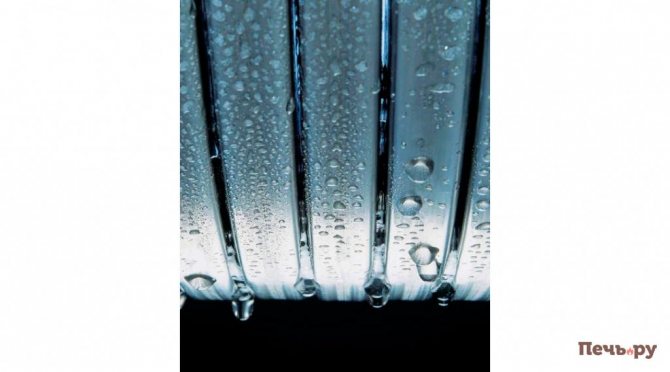

How to pour coolant into the system
If you have a heating system with natural circulation, then the coolant must be placed in an expansion tank, which is better placed slightly above the highest point of the system and connected with a strong hose.
The main thing to take into account here are two points:
- Bleed air (check all installed taps, if you use float valves that release air automatically, then just watch the filling);
- Make sure that the container is not empty, because then an air lock will form in the system and the liquid will have to be drained again.
Thus, if ordinary taps are used, then it is better to carry out the filling together - one person makes sure that the container is filled all the time, and the second checks the taps. If there are automatic taps, you can pour liquid into the structure yourself.
If you operate an installation with forced circulation, then the coolant must be supplied under pressure, using a pump with a bottom water intake.Connect a durable hose to it and fix it well at the joints. Dip it into a container with antifreeze and turn on the pump.
There are also nuances here:
- Since the pump empties the container rather quickly, it is imperative to monitor its filling in order to avoid the formation of an air lock;
- Monitor the pressure in the system (so that it does not rise above 2-3 atmospheres), turn off the pump in time;
Before pumping antifreeze, it is better to fill the installation with water a day in advance to make sure it is tight. Revealing a leak after the "non-freezing" is in the system is undesirable, since it is toxic and can get into the living space. And to drain the liquid for troubleshooting is problematic.
If water was previously used in heating, then you must definitely pay attention to the fact that it has greater expansion properties than antifreezes. And before using them, it is necessary to change all the seals at the joints in order to avoid leaks.
It is also worth considering that it will not be possible to drain all the water from the system, and then additional dilution of the anti-freeze agent will occur. To avoid loss of density, you need to mix the antifreeze solution with the concentrate approximately 1: 1.
Non-freezing liquids are not used if:
- You have galvanized pipes installed. This will entail chemical reactions as a result of which a lot of salt precipitation is formed, which will block the operation of the heating system;
- They are produced on an ethylene glycol basis, and you have a double-circuit boiler in operation. In this case, the ingress of antifreeze from the heating cycle into the water supply circuit is not excluded, and this is dangerous to human health.
- You have an open heating system, as the non-freezing agent can evaporate and its vapors are toxic.
Features of using antifreeze
As you can see, non-freezing is significantly different from water, which means that it is important to take into account some of the nuances of operating the heating system in the house after you figure out how to pump antifreeze into it, and do it for the first time.
Pay attention to the following points:
- it is necessary to purchase and connect a circulation pump that could produce sufficient pressure in the pipes;
- the boiler must have at least 20% power reserve.
Do not rush to purchase an anti-freeze until you are sure that it can be poured into your heating system for a private house. Here is a list of important points to pay attention to before ordering battery antifreeze:
- if you use an electrode electric boiler, then it requires a special "anti-freeze". Pay attention to the recommendations from the manufacturer;
- if you have a double-circuit boiler, then you will have to refuse antifreeze liquid. There is a risk of liquid entering the DHW circuit;
- do not use low temperature mortar in a system with galvanized pipes. A chemical reaction will provoke the loss of antifreeze of its basic properties;
- Filling an antifreeze system with an atmospheric expansion tank is a bad idea. Firstly, you and your loved ones will constantly inhale harmful anti-freeze vapors, and secondly, the volume of antifreeze will constantly decrease due to fumes.
Related article: How to properly install a ball valve on a pipe with your own hands: step by step instructions
Advice: Is it possible to pour an anti-freeze into the system after water? Experts answer that it is possible, but it is important to pay attention to one aspect of the pump's operation. It may turn out that the unit, which previously worked at low or medium speeds, will simply need to be switched to its maximum power, and this will be quite enough for correct operation.If the pump power is not enough, or you see that something has gone wrong (the batteries do not heat well), then the unit will still have to be replaced.
Influence of the composition on heating
Antifreeze for filling tanks, which is available on the market, is made from one of two substances:
- monoethylene glycol;
- propylene glycol.
Each of the substances differs in characteristics and properties and has its own purpose.


Fill
Monoethylene glycol
This compound is a dihydric alcohol, and is the simplest representative of the polyol group. In its pure form it looks like a transparent, oily liquid. Has no smell. Refers to toxic substances and, if ingested, can lead to severe damage or death.
When using monoethylene glycol for heating, the following features must be taken into account:
- When starting the system using such a composition, it is advisable to start electric boilers with a minimum power level. After that, it is necessary to gradually increase the parameter of the heat received, while it is possible to allow the limit value to be exceeded.
- Monoethylene glycol may only be used in closed circuits with one line. The substance is poorly soluble in water, therefore, if it enters the water supply system, it can lead to poisoning.


Substance based on monoethylene glycol
Propylene glycol
In the functional composition, the differences are minimal. Instead of diatomic, unsaturated ethylene, the more common triatomic propylene is the basis. The main difference that leads to the use of propylene glycol in heating is harmlessness to a living organism. It can be poured into any type of system.
Choosing the right fluid is difficult for many reasons. There are many aspects to consider, including pipe material, aluminum, stainless steel or plastic. Non-freezing coolant requires high costs associated with the purchase and installation of equipment, insofar as it is necessary to install a pump for forced water supply.
It can be difficult to calculate the parameters yourself, so it may be necessary to involve a team of specialists, both for design and for installation of the system. When using antifreeze, you will have to decide how to cool the tank. The boiling point of organic alcohols, which are used for this purpose, is significantly higher than that of water, which also requires attention during design.
In addition, there are many product options on the market that differ in operational parameters.
https://youtube.com/watch?v=ePyAZ3vEUr0
Propylene glycol
The "Eco" logo is often used on the packaging of liquids of this type, which indicates complete safety of use at normal temperatures. They can be used in double-circuit boilers, since the ingress of a small amount of propylene glycol into the water usually does not cause negative consequences. The level of heat capacity here is higher than that of ethylene glycol. The propylene glycol solution, as it were, lubricates the walls of the pipeline, reducing the overall level of hydraulic resistance. This leads to a decrease in heat loss and increases the efficiency of the heating system.


As for the inadmissibility of contact with galvanized products, propylene glycol antifreeze also has this drawback. The price of this type of heat carrier is an order of magnitude higher than that of ethylene glycol. Antifreeze goes on sale in a ready-to-use form: special additives bring the fluid's longevity to almost 10 years. In general, this substance is an excellent solution to the question of what is the best antifreeze for heating a house.


b356b770e14ddf5cfaba674c591e843e.jpe
Which type to give preference to?
Non-freezing mixtures differ in cost and chemical composition
Therefore, when choosing, you need to pay attention to the properties.There are a large number of products on the market that have suitable parameters from many manufacturers.
The choice of a specific mixture for the needs can be significantly complicated by non-obvious advantages and disadvantages. For a long time, favorites have appeared on the market among liquids.
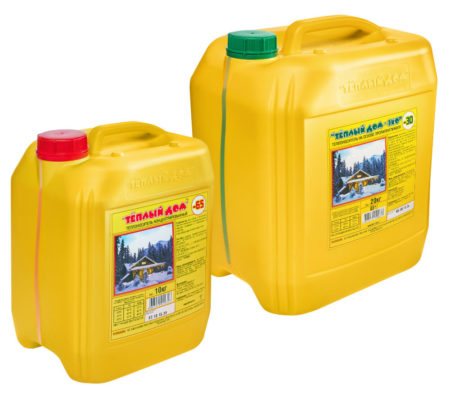

Warm house
One of the most widespread and popular brands is the "Warm House" article, produced in Russia. Due to the absence of transport costs and duties, the cost of the goods is quite stable and affordable.
The advantages of this mixture are in high performance properties. Once filling the tank, you can not replace it for the next several seasons. You can not change the liquid for 5-10 years. The feature is indicated on the labeling, so it is worth focusing on it as well.
The cost of mixtures varies depending on many factors: volume, ingredients and manufacturer. Therefore, you will have to choose among a large number of options. Domestic and foreign manufacturers are expanding the range of goods. Moreover, the updated options are distinguished by reduced harm to health in the event of an accident. Raw materials for the production of mixtures due to the use of new cleaning methods are becoming of a higher quality. To improve the characteristics, propylene glycol for the food industry is chosen as the main component.
Recommendations for the selection and operation of heat carriers - which one is better to choose
None of the manufacturers of heat carriers will refute the fact that in the case of stable operation of the heating system in winter, it is water that is the best option, which heat carrier to choose for heating. It is better if it is a special distilled liquid with modifying additives, as mentioned earlier. Homeowners who consider buying store water a waste of money usually do their own preparation, softening it, and fitting the system with the right filters.


If it was decided to use non-freezing coolants, it is important to have information on the conditions that exclude the likelihood of their use:
- If the house has an open system.
- When using natural circulation in the circuits: such a concentrate of the coolant for heating the system simply "will not pull".
- The presence of pipes or other elements in contact with the coolant with a galvanized surface is unacceptable.
- All connecting assemblies equipped with seals made of tow or oil paint must be repacked, since glycolic substances will destroy them very quickly. As a result, antifreeze will start to flow, creating a real threat to people in the room. The old tow can be used as a new sealing material by treating it with a special sealing paste "Unipak"
- It is forbidden to use non-freezing liquids in those systems that are not equipped with devices for accurately maintaining the temperature of the coolant. The heating level dangerous for glycol antifreezes starts already from + 70-75 degrees: these processes are irreversible and fraught with the most unpleasant consequences.
- Usually, after pouring antifreeze into the system, it is required to increase the power of the pumping equipment, install a larger expansion tank, and increase the number of battery sections. Sometimes it is necessary to change pipes to wider ones.
- Incorrect operation of automatic air vents after pouring antifreeze was noticed: they are recommended to be replaced with Mayevsky taps.
- Before pouring antifreeze, the system must be thoroughly cleaned and rinsed. This is done using special formulations.
- To change the concentration level of antifreeze, use only distilled water.In this case, it is better to resist even from the use of purified and softened water.
- The correct concentration of antifreeze coolant for heating systems is of utmost importance. It is better not to expect that the winter will not be very harsh by overly diluting antifreeze. It is recommended to adhere to a threshold of -30 degrees, even in traditionally warm regions. In addition to protection against abnormal frosts, this will create optimal conditions for inhibitors and surfactants, the effectiveness of which is noticeably reduced with an excessive water content.
- After filling with new coolant, it is forbidden to immediately turn on the maximum mode of the system. It is best to build up power smoothly so that the antifreeze has time to adapt to new conditions and circuit elements.
- Studies show that at present the most reliable antifreeze coolant is a propylene glycol composition. Ethylene glycol is too dangerous, and glycerin is so controversial that it is rarely used. So it's better to overpay, but sleep well at night.
Non-freezing coolants - antifreeze
Strengths and weaknesses of anti-freezing liquids
After purification and enrichment with useful components, water turns into a good heat carrier. However, its main drawback is freezing, which cannot be overcome in this way. Therefore, systems with unstable operation in winter are recommended to be filled with special fluids with a lower freezing level. They are called antifreezes: they are well known to motorists, as they are used in engine cooling systems and glass cleaning.
Advantages of antifreeze:
Low freezing point
At the same time, which is very important, even their crystallization does not provoke hardening and volume expansion. Although the fluidity level of the gel-like substance does not allow the heating to function normally, this completely eliminates the risk of damage to pipes, radiators and heat exchangers.
After normalizing the temperature, the non-freezing coolant completely restores its fluidity, which does not affect its performance in any way.
Possibility of adding water. The freezing level in normal concentration is about -65 degrees. Such an ultra-low temperature regime is rare in nature, which makes it possible to dilute antifreeze with distilled water. As practice shows, the lower limit of -35 degrees will suit all regions of the country.
Chemical stability. It is typical for most modern antifreezes. Although the range of operating temperature differences is very significant, the service life of a high-quality coolant without replacement can reach 5 years.


Considering antifreezes in a qualitatively potential use as a coolant, it is important to know the negative aspects:
- High viscosity level. It is an order of magnitude higher than that of water, therefore, good circulation of non-freezing liquids along the circuit is possible only with powerful pumps. If the house is equipped with a natural circulation heating system, the use of antifreeze as a heat carrier is completely excluded.
- Low heat capacity. Even the most effective non-freezing heat carrier for heating in this regard is usually inferior to water by at least 15%. It seems that the figure is not large, but on the scale of the heating system of an entire building, the consequences of such a difference are very significant, and are expressed in a decrease in efficiency, an increase in the cost of maintaining the desired temperature, and the need for a larger number of powerful radiators.
- High level of penetration through gaskets. Despite the higher viscosity of antifreeze, even those seals that remained dry on the water do not hold it. Therefore, if the coolant is replaced, it is imperative to repackage all fittings and threaded connections.In this case, the aggressiveness of anti-freezing liquids should be taken into account, which implies the use of only chemically resistant seals.
- Toxicity. Most antifreezes contain chemical compounds harmful to humans that can cause severe poisoning, damage to the skin and mucous membranes. Therefore, the systems where they are used must be as tight as possible in order to exclude the slightest chance of leakage or evaporation of liquid. In any case, antifreeze cannot be used in double-circuit boilers, where there is a real risk of the coolant entering the hot water pipes.
- High level of thermal expansion. This indicator for antifreeze is an order of magnitude higher than that of ordinary water. Because of this, larger diaphragm expansion tanks have to be used. The use of cheap open-type expanders in this case is completely excluded, since this threatens not only with the evaporation of an expensive heat carrier, but also with the ingress of toxins into the indoor air. Currently, three types of antifreeze coolants are widely used - based on ethylene glycol, propylene glycol and glycerin.
Varieties of antifreeze and their properties
Antifreeze, or antifreeze liquid, is a mixture of several substances. The composition includes distilled water, propylene glycol or monoethylene glycol and inhibitor additives.
Typically, two types of anti-freeze liquids are used for heating systems in a home and industrial ventilation systems:
- with ethylene glycol. In this antifreeze the following percentage of the components: 63%, 31%, 6% (ethylene glycol, water, additives);
- with propylene glycol. This antifreeze has a lower concentration of the main active ingredient: 46%, 50%, 4% (propylene glycol, water, additives).
If you have never dealt with non-freezing before, then please note that this liquid differs from ordinary water in several ways at once:
- by viscosity;
- by fluidity;
- by thermal conductivity.
This means that antifreeze requires special operating conditions. How it works? Antifreeze imparts a higher resistance (in terms of hydraulics) to the piping networks and ducts in the batteries. This means that it will be necessary to pump the anti-freeze through the pipes with greater intensity - that is, the system with antifreeze requires more pump pressure for correct operation. But the heat transfer of antifreeze is 2 times higher than that of water - accordingly, it will take 2 times less heat energy to heat an anti-freeze.


Important: Please note that ethylene glycol is toxic and gives off harmful fumes. However, as can be seen from the composition of the anti-freeze, it almost half consists of purified water. In addition, before pouring antifreeze into the system, it must still be diluted with water. This suggests that the harmful properties of ethylene glycol are leveled.
Blitz Tips
- "Non-freezing" is ideal for heating houses. which are rarely visited in winter and the system is turned off most of the time;
- Choose special equipment for using antifreeze;
- It is better to purchase radiators with a power 30-40% higher than that of conventional ones;
- Due to the increased viscosity of anti-freeze agents, it is advisable to use pumps with reinforced hydraulics;
- If necessary, prepare a solution from the concentrate. then use only distilled water for this;
- Do not mix different types of antifreeze, it is better to use one. But if there is no other way out, then first mix them in a container and observe whether a precipitate falls out;
- The use of automotive antifreeze in heating structures is unacceptable. since it contains components, the use of which is unacceptable in residential buildings;
- It is better not to use a concentrate with a freezing threshold of -65 degrees Celsius in its pure form. this will lead to overheating of the heat exchanger and decomposition of the additives;
- But if a solution with a freezing temperature of no more than -25 degrees is used in the system, and the temperature has dropped below (which is unlikely), then you should not worry. The heating installation will not be damaged at all. Antifreeze will thicken, and when the temperature rises, it will return to its original state, without loss of properties.
- Automotive sealant can be used to prevent leaks at the seals.
How to use anti-freeze
The new working fluid is poured into the pipes after draining the old one, while the system must be tight and efficient. It is advisable to dilute the non-freeze with water according to the instructions. To see if the system can be started, check the following points:
- When switching from water to an antifreeze liquid, it is recommended to install a more powerful pump due to the increased viscosity of the liquid;
- It is recommended to increase the operating temperature mode of heating due to the low heat capacity of the coolant;
- The boiler power must have a reserve of at least 20% of the nominal;
- Galvanized parts and assemblies must be replaced with stainless or brass ones;
- The start-up and adjustment of the equipment is carried out at the minimum values of the technical and operational indicators of the system;
- Antifreeze and other similar fluids may only be used in closed-type heating systems.
Characteristics of antifreeze heating fluids
The way a low-freezing liquid for heating systems behaves in the circuit is primarily influenced by the quality of the additive package and, of course, the operating conditions. Regardless of which main active element is added to the glycol base, all formulations have anti-corrosion and anti-foaming properties.
Without these additives, the heating fluid is very corrosive. All non-freezing liquids foam, but especially glycerin anti-freezing liquids for heating systems of houses. Foam is an air-containing substance, and air leads to impaired circulation, the formation of air pockets, as well as water hammer in the heating system.
The additive package has its own time resource. After a certain time, the additives disintegrate at the molecular level.
In this case, a precipitate is formed and acid is released. It turns out that nothing already smooths out the aggressiveness of the coolant for heating the house, moreover, everything is aggravated by the release of acid. Service life of antifreeze liquid:
- based on ethylene glycol - five years;
- based on propylene glycol - five years;
- glycerin-based - up to ten years.
This is the service life of the compound under favorable operating conditions. The main requirement is, of course, temperature. When the temperature of the coolant rises to 90 degrees, the non-freezing liquid begins to disintegrate and loses its properties. This only happens if the boiler starts up incorrectly after a long period of inactivity, or errors during installation.
Direct contact of the heat exchanger with the flame is undesirable if antifreeze is poured into the circuit
For example, when a heat exchanger is built into a conventional oven. Some people install it so that it is in contact with an open flame. If you plan to use antifreeze for stove heating, then this should not be done. It is necessary that there is a layer of brick between the heat exchanger and the flame. He and the coolant will protect from too hot tongues of flame, and distribute the heat evenly. In this case, the non-freezing liquid for stove heating will not overheat.
Characteristics influenced by the quality of the additive package:
- thermal conductivity;
- density;
- viscosity;
- fluidity;
- thermal expansion.
The higher the quality of the additives, the higher the characteristics will be. That is, as close as possible to the characteristics of water. In the case of the coefficient of thermal expansion, then it should be as small as possible.
Taking into account the fact that the volumetric expansion of the anti-freeze is greater than that of water, it is necessary to provide for an expansomat of 40% more volume.
The thermal conductivity of antifreeze is lower than that of water. The lowest thermal conductivity of glycerin antifreeze liquids. In relation to water, it is only 85%; in other non-freezing systems, the indicator can reach 90%. As you can see, the difference is not that great.
Non-freezing liquids are half as dense and viscous as water. These qualities impede circulation. In order to pump the coolant along the circuit, a pump of greater power will be required; it would also be nice to assemble a heating circuit from pipes with a cross section larger by one step. For example, when it comes to polypropylene pipes. then instead of 25 in diameter, it is better to take 32.
Despite the fact that the non-freezing liquid is denser and more viscous, it has a lower coefficient of surface tension, that is, it is more fluid. Do you know that you can draw water into a glass "with a slide"? The slide, of course, will be small, but even visually it is visible that the liquid rises above the edge of the vessel. With anti-freeze, this will not work. Due to this high fluidity, it flows out where water does not penetrate due to surface tension. In other words, if there are microcracks and even very small holes, then the non-freezing liquid will find a way out there.
Therefore, often, after there was water in the circuit and it was decided to pour an anti-freeze into it, leaks appear. Major leak points:
- pipe joints;
- connections between radiator sections;
- places for connecting additional elements;
- in the boiler itself.
Water has another useful property, thanks to which a minor leak can disappear by itself. Metal particles settle at the edges of the cracks and seal them. Of course, this is just scale, which, in the case of flushing and further pressure testing of the system, will be removed and flow will resume.
When anti-freeze is applied
Safe non-freezing liquid for heating
A heating medium circulates in the heating system. It can be water or non-freezing heating liquid. The main purpose of the coolant is to absorb heat from the heating elements of the boiler and distribute it to all heat exchangers. Through them, the coolant gives off its heat to the room and returns again to the boiler. It turns out that the coolant also works as a coolant for the heating system, which simultaneously cools the boiler heat exchanger and heats up the radiators. This cycle only takes place when the heating is active.
If the boiler does not work, as well as the pumps in a sealed circuit, then the circulation of the coolant liquid for heating stops. Together with it, respectively, the coolant ceases to receive energy from the heating elements of the boiler. The process of decreasing the temperature begins in accordance with the weather conditions. The cooling rate depends on the degree of insulation of the room, that is, the level of its heat loss. In winter, when the boiler is off, the coolant gradually reaches the crystallization temperature and turns into ice.
Ice has a larger volume than liquid, so it literally breaks pipes. To prevent this from happening in circuits where the heating is switched on irregularly, it is necessary to fill in an anti-freeze liquid for the heating system. In what situations can the heating circuit work irregularly:
- in a temporary residence house;
- in the country;
- in the garage;
- if there are power outages for a long period.
Spontaneous power outages are not terrible if you have an uninterruptible heating system that will supply all volatile elements with current. But this is effective only if it is installed in a house where someone constantly lives. But in the country, this method is not applicable.Typically, in country cottages, heating is turned on only on weekends, and the rest of the time the circuit is idle. Accordingly, only non-freezing liquid for the heating system can be used as a heat carrier. You do not plan to fill and drain water every time you want to heat the house. Moreover, there will be at least 200 liters in the heating system.
All about how to make heating of greenhouses with your own hands from scratch.
How to calculate the heating of a greenhouse without the help of a specialist, read here.
Using antifreeze for heating systems


Antifreeze or antifreeze liquids are known to almost everyone. They are widely used in vehicle cooling systems in winter. In a car engine, antifreeze transfers excess heat from the engine, cooling it down. Moreover, even in the most severe frosts, it does not freeze. It is these properties - the ability to transfer heat even at the lowest temperatures and have led to the use of antifreeze for the construction of heating systems. It is especially important to use such a coolant in a system, part of the pipeline of which runs through an open area.
A good feature of “non-freezing” is that it provokes less corrosion on the inner surface of pipeline systems than ordinary water. Another undoubted advantage is the absence of suspended limestone solutions in antifreeze liquids - so you don't have to worry about possible scale formation.
There are several modifications of antifreeze fluids that can be used in heating systems. The choice of a specific type is made taking into account the climatic conditions and the configuration of the heating system of your home.
Heating system flushing fluid
In addition to the heat carrier itself, when operating the heating system, you will also have to purchase a liquid intended for flushing with a pipeline and heating radiators.
Of course, as a last resort, you can rinse the inner surface of the pipes with ordinary tap water, but it is better to do this all the same with the help of special fluids, in which special chemical additives are introduced.


An alternative flushing option can be the use of water with a caustic soda solution added to it. Such a mixture is poured into the heating system and remains inside it for about an hour. The soda solution comes into contact with scale on the inner surface of the system and dissolves it. In addition, the baking soda solution will dissolve the corroded areas.
How to choose a liquid for a heating system
First of all, it is necessary to determine the operating parameters of the system. Here two extreme values will be important to you - the maximum temperature of the coolant when heating in the boiler and the minimum temperature of the ambient air. Next, you need to carefully study the technical characteristics of your heating system.
Actually, the main attention should be paid to the characteristics of the heat exchanger in the boiler. Some manufacturers may not allow the use of anti-freeze fluids. And, finally, after determining the permissibility of using an anti-freeze liquid and its possible temperature parameters, proceed directly to the choice of the brand of liquid, focusing on its lowest toxicity
All the same, the heating system will be located in a residential area, and possible fluid leaks should not lead to poisoning.
Using alcohol as a heat carrier
No matter how blasphemous it may sound for a man's ear, it is allowed to use alcohol as a heat carrier. The alcohol does not freeze and can be used over a wide temperature range.Naturally, industrial alcohol is used in this capacity, which is a deadly poison for humans. However, many manufacturers of boilers and heat exchangers are critical about the use of fluids such as bischofite or ethylene glycol as a heat carrier.


The disadvantage of using pure alcohol as a heat carrier is its high volatility - about five liters per year will evaporate through microscopic pores in the system.
Pros and cons of non-freezing in the heating system
Let's take a look at when it is advisable to pour antifreeze into the heating system of a private house. Judging by the reviews, switching to antifreeze can ensure uninterrupted operation of heating, however, some nuances should be taken into account. So, antifreeze is really needed in regions with harsh climatic conditions, where winters are long and frosty. Non-freezing, unlike water, will prevent pipes from freezing, deforming and bursting.
Antifreeze is an irreplaceable assistant for country cottages and summer cottages equipped with a heating system. If you do not plan to live there all year round, you will not be able to monitor the condition of the pipes in winter, and the anti-freeze will prevent them from freezing and deteriorating.
Pros of antifreeze:
- you can not drain antifreeze from an idle system for a long time;
- due to the fact that pipes and radiators are filled with a coolant, air does not enter them;
- due to the presence of additives in the antifreeze, the risk of foam formation, corrosion and scale is reduced;
- non-freezing still freezes, but at temperatures from -30 ° C to -65 ° C, depending on the concentration of antifreeze;
- the viscosity of the anti-freeze can be reduced by diluting it with water. So you can save the volume of the coolant and save the circulation pumps.
Cons of antifreeze:
Types of antifreeze
The market for this specific product is very extensive. Recently, due to the increased demand for anti-freeze products, manufacturers have greatly expanded their assortment.
Non-freezing liquids are made on the basis of various chemical compounds:
- Glycerin;
- Ethylene glycol;
- Propylene glycol;
- Bischofite brine;
- Saline solution.
The most common household "non-freezing" products are made on the basis of aqueous solutions of ethylene glycol, glycerin and propylene glycol. Since these substances are highly aggressive, special components are added to them - additives.
The purpose of which is to prevent damage, corrosion, scale and foaming.
- Ethylene glycol is the most popular among our consumers. Their main advantage is their low price. But at the same time it is the most toxic non-freezing liquid, the use of which in double-circuit boilers is prohibited, due to the high probability of entering the water supply system, which is dangerous to human health. It should be borne in mind that when the boiling point rises above 110 degrees, ethylene glycol gives a precipitate that can damage some elements of the system.
- Propylene glycol are similar in properties to the first type, but at the same time they are harmless and safe. Most of the manufacturers recommend them.
- Glycerin is absolutely non-toxic and environmentally friendly, providing maximum protection against corrosion. It does not increase in volume when it goes into a solid state, and it is enough to simply heat it up to start the system.
- Antifreezes based on a natural bischofite solution have unique physical and chemical properties. Low freezing point and high boiling point, as well as greater heat capacity and heat transfer than water, which is not typical for most of these products.
- Salt coolants are produced on the basis of solutions of mineral salts (magnesium, calcium, sodium and their compounds). A significant disadvantage of these fluids is their high corrosiveness to equipment.
Antifreezes are sold either already diluted and ready for use (experts recommend using a coolant with a freezing point of -20 to -25 degrees), or in the form of concentrates, and then the solution must be prepared independently.
An example of diluting ethylene glycol fluids. They are of two types:
- With a freezing threshold not higher than -30 degrees (then, to come to a freezing point of -25, the mixture must be diluted with distilled water in a ratio of 9: 1);
- With a freezing threshold not higher than -65 degrees (to get a freezing threshold of -25, antifreeze is mixed with water in proportions of 6: 4).


Influence of the composition of liquids on heating
Non-freezing fluids for heating systems currently on the market are made on the basis of two substances.
Monoethylene glycol
This component has the following features:
- if such an anti-freeze is used in the heating system, then when the system starts up, its operation should start with the minimum power. Then this parameter can be gradually increased to the required values, temporarily exceeding the level of the required power;
- antifreeze, the main component of which is monoethylene glycol, is a fairly toxic product. Therefore, it should be used in single circuit systems.
Propylene glycol
If you compare it in terms of workflow, then there are no differences. However, there is one positive point. It lies in the safety of this non-freezing liquid. Its use in the heating system of a private house does not cause any harm to human health.
Which non-freezing liquid to choose, everyone decides for himself. However, it should be noted that it is impossible to answer unequivocally which coolant is the most suitable for the system of a private house - water or antifreeze. If the price of antifreeze liquid is too high for you, then in this case water is the right choice.
In order not to be mistaken with the choice of the coolant, attention should be paid to a number of parameters. It will not be superfluous to consult a specialist
Following his recommendations, your choice of coolant will be successful.
Selection recommendations
Water, unlike any antifreeze, is an environmentally friendly liquid. However, it can cause scale and corrosion. However, if the family lives in the house permanently, water is a more acceptable option for heating.
But it is better to use special fluids when, in the cold season, the heating is turned on from time to time. The fact is that if the heating was not started at the onset of cold, there is a risk of pipe breakage due to an increase in the volume of water during the transition to a solid state. With antifreeze, this problem is excluded.


When choosing antifreeze, you need to rely on the heating system itself
The elements for the heating system themselves must be chosen taking into account what exactly will be used - water or antifreeze, then the risks will be much less. But if the heating system has been working for a long time and it was decided to change the water to an anti-freeze, then when choosing one or another of its types it is recommended to consider the following:
- a certain type of anti-freeze for heating a private house should be selected, focusing on the very design of the heating system. It is important here what metal its parts are made of, what power the pumps and radiators have, and what type of boiler is used;
- the composition must be reliable and of high quality;
- navigate the properties of the additives that are contained in antifreeze, in order to know how it can affect the material of the equipment;
- it is necessary to dilute the non-freezing liquid strictly according to the instructions;
- when using, do not forget about the service life of antifreeze (in most cases it can be used no longer than 5 years).
If the liquid is purchased for the first time, you can contact a specialist in the store who will advise the most suitable option for each individual case.The correct choice is a guarantee that the heating system will work fully.












